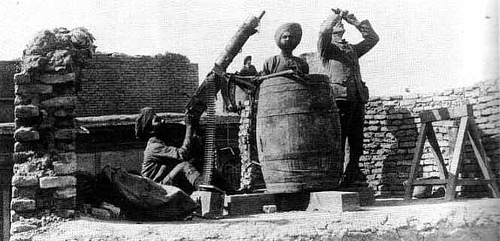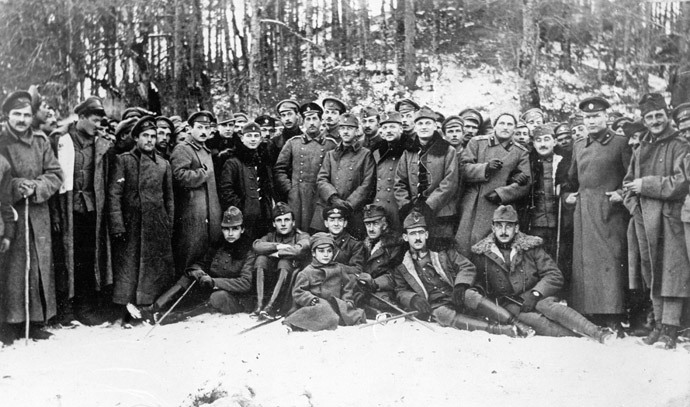Ottomans Stunned at Fall of Erzurum on Caucasus Front;
Relentless Turkish Siege of British at Kut .
Special to The Great War Project.
(16-19 February) In the Mesopotamian [Iraqi] desert, the Turks tighten their deadly noose around the small and increasingly hungry British and Indian troops at Kut.

Indian gunner at Ottoman siege of Kut, circa early 1916.
In mid-February 1916, precisely a century ago, the Ottomans send the first aircraft carrying bombs over Kut. “One morning,” writes historian Eugene Rogan, “a low-flying Fokker monoplane circling over the skyline captivated the bored soldiers and townspeople of Kut.”
Rogan quotes one British officer’s account of the unusual attack. “Everybody was interested as it was obviously a very fast machine,” the British officer recalls. “It circled round the south of the town and then when it had turned northwest again, it was seen to drop something that shown in the sun for a moment – in fact four such things were seen to drop and interest increased.”
Writes Rogan: “Until this point aircraft had only been used for aerial surveillance…
“This was the first time the people in Kut had witnessed an aerial bombardment.”
The soldiers are shocked when the bombs hit the ground and explode. The first attack results in one residence and one artillery piece destroyed. Some sentries are buried in their trenches, but no one is killed. Later Turkish bombing runs turn more lethal, killing many.
“Aerial bombardment added significantly to the tightening of the siege of Kut,” reports Rogan.

Rudimentary anti-aircraft used by British and Indian troops at Kut.
But on February 18th a century ago, the Turkish guns fall unexpectedly silent. The British are confused and fear the Turks are preparing for a full-fledged attack on the town.
“Only on the following day,” writes Rogan, “did they realize that the halt in hostilities reflected the Ottomans’ shock on learning of the fall of Erzurum.”
Erzurum is one of the Armenian-dominated towns in eastern Turkey, hundreds of miles north of Kut. The Ottomans are locked in a battle with the Russians there for control of Erzurum and thus of the Caucasus front.

Russian troops at the battle for Erzurum, January-February 1916.
The Turks believe Erzurum is well protected by fortresses guarding the city. And the town is recently reinforced by Turkish troops moved from the Gallipoli Peninsula, after the British are defeated and have abandoned the Dardanelles front in northwest Turkey.
But Russian troops open an attack on Erzurum on February 11th 1916. The fighting is fierce, even hand-to-hand. Russian troops have further successes the following day. “It was clear,” writes Rogan, “that after the shock of the Russian assault, the defenses around Erzurum had collapsed, and the Ottomans were in full retreat.”
The Russian Cossack cavalry flood the town on February 16th. It is the first good news for the Russians since the very beginning of the war in 1914.

Russian troops posing with captured Ottoman flags at Erzurum, February 1916.
“The moment,” reports Rogan, “captured the imagination of the Russians and their allies after eighteen months of static trench warfare and catastrophic losses on both the Western and Eastern fronts.”
The Russians take 5,000 Turkish prisoners. Casualties are 10,000 and another 10,000 Turkish troops are deserters.
“Here at last was a moment of glory, of men on horseback driving the enemy into headlong retreat.”
Writes Rogan, “it is the greatest territorial loss the Ottomans had yet suffered in the war.”
As a result the Ottomans redouble their efforts to strangle the British still under siege at the Iraqi city of Kut.

Mike, as much as I enjoy your writing in these posts, if it hasn’t been commented upon yet, your choice of photos in the posts are fascinating (often unsettling, sometimes graphic as well, but such is the nature of war).
Honestly, the last image in this post looks like the front of a picture postcard to send home. And the Russians pictured above that – in the front row it looks like there’s a child sitting with the soldiers!
I very much appreciate your comment about the graphics in the blog. I try to pick photos and other graphics that as accurately as possible illustrate what the entry is about. And that depict the conditions of the war. They may be hard to look at sometimes, but they are no less important to bring the war, in its vastness, out in the open. I’m indebted to those who have curated these photos. They are incredible to work through.